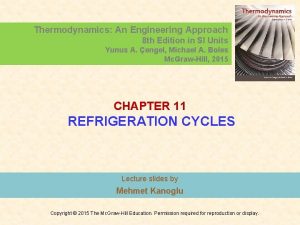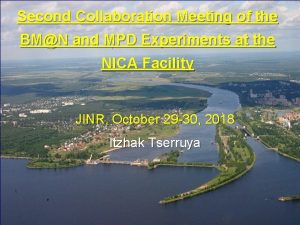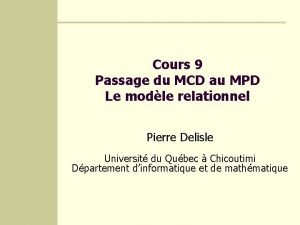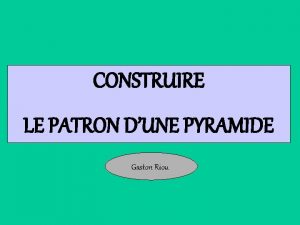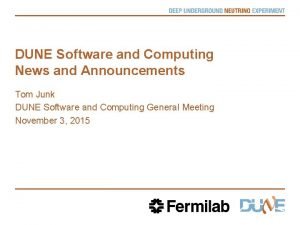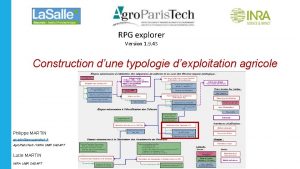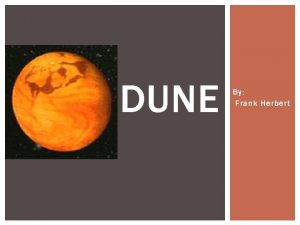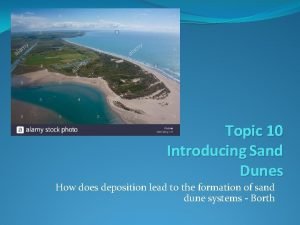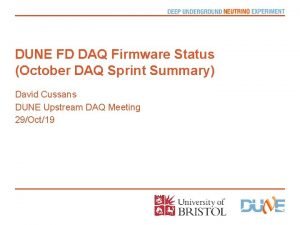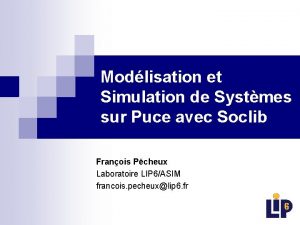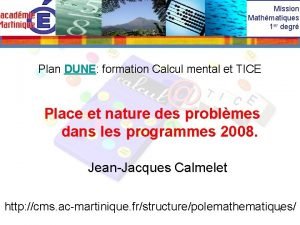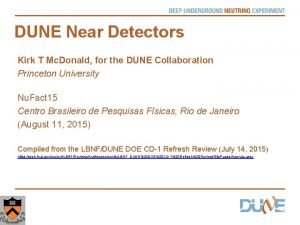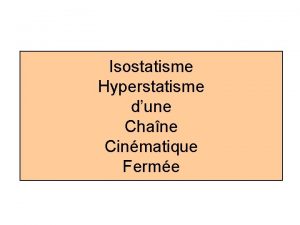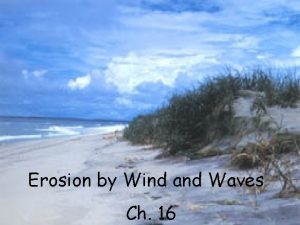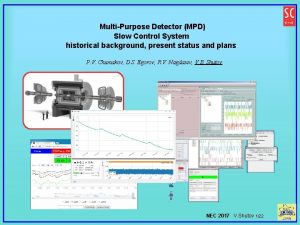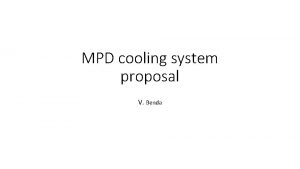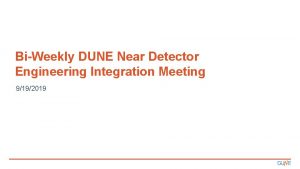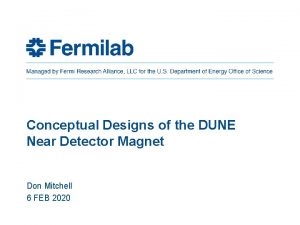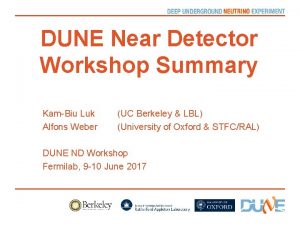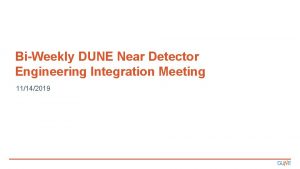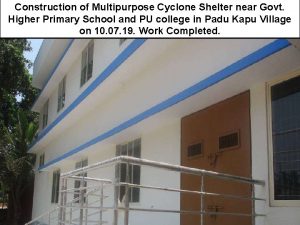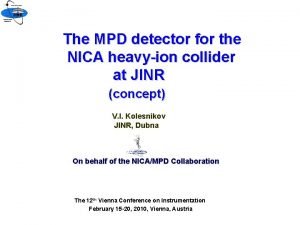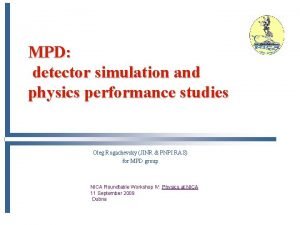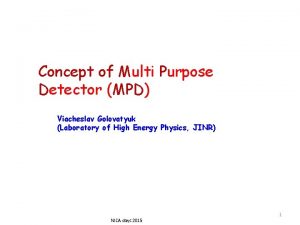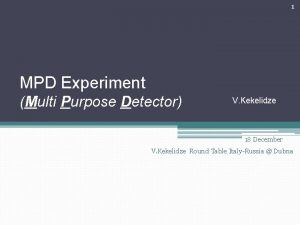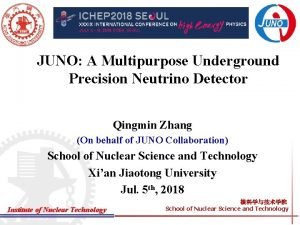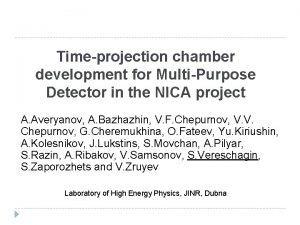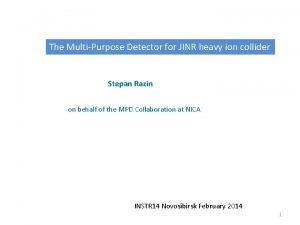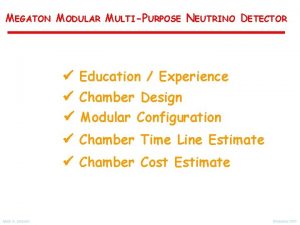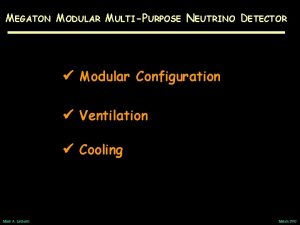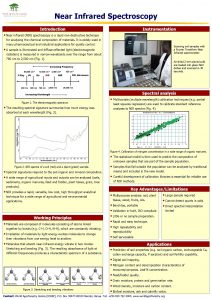The DUNE Multipurpose detector MPD DUNE Near Detector





































- Slides: 37

The DUNE Multi-purpose detector (MPD) DUNE Near Detector discussion meeting-- TIFR Alan Bross February 27 th, 2020

Multi-purpose detector (MPD) Design Status

MPD components • Magnetized high-pressure (10 atm) gaseous argon TPC + ECAL + muon tagger • • Magnet ECAL Copy of ALICE TPC (5 m in diameter X 5 m long active) 0. 5 T field • HPg. TPC surrounded by highperformance ECAL • • Calorimetric analysis for neutrals Optimization study underway • Muon tagger • 3 Incorporated into return Fe Feb. 27 th, 2020 MPD Design Status TPC

Overarching ND Requirements & MPD O 0: Predict the neutrino spectrum at the FD: The Near Detector (ND) must measure neutrino events as a function of flavor and neutrino energy. This allows for neutrino crosssection measurements to be made and constrains the beam model and the extrapolation of neutrino energy event spectra from the ND to the FD. O 0. 1 Measure interactions on argon Measure neutrino interactions on argon, determine the neutrino flavor, and measure the full kinematic range of the interactions that will be seen at the FD. O 0. 2 Measure the neutrino energy Reconstruct the neutrino energy in CC events and control for any biases in energy scale or resolution. O 0. 3 Constrain the xsec model Measure neutrino cross-sections in order to constrain the cross section model used in the oscillation analysis. O 0. 4 Measure neutrino fluxes as a function of flavor and neutrino energy. O 0. 5 Obtain data with different neutrino fluxes Measure neutrino interactions in different beam fluxes in order to disentangle flux and cross sections and verify the beam model. (PRISM) O 0. 6 Monitor the neutrino beam energy spectrum with sufficient statistics to be sensitive to intentional or accidental changes in the beam on short timescales. MPD contributes 4 27 -Feb-2020 MPD Design Status

MPD requirements • Measure particles that leave the LAr ND component and enter the MPD • Constrain neutrino-nucleus interaction systematic uncertainties • Precisely measure all-components of the neutrino flux - nm, nm-bar, ne-bar • Reconstruct neutrino energy via spectrometry and calorimetry • Constrain LAr. TPC detector response and selection efficiency • Measure energetic neutrons from n-Ar interactions via time-of-flight with the ECAL (Desired) 5 Feb. 27 th, 2020 MPD Design Status

MPD essential characteristics 6 Feb. 27 th, 2020 MPD Design Status

MPD’s characteristics II Ø Downstream muon spectrometer for LAr detector with HPg. TPC Ø Large acceptance Ø Minimizes material between LAr/HPg. TPC Ø Observe n-Ar events with: Ø Fully hermetic with 4 p coverage Ø Sign-selection, magnetic spectrometry Ø Very low tracking thresholds Ø Minimal secondary interactions Ø Disentangle n-Ar from secondary interactions in the detector Ø Powerful tool in transferring ND measurements to FD Ø Opens new opportunities to study physics beyond the n. SM 7 Feb. 27 th, 2020 MPD Design Status

Event rates in HPg. TPC FHC Event Class nm. CC-bar ne. CC-bar 8 Feb. 27 th, 2020 MPD Design Status #evts per year 1. 5 X 106 5 X 104 2 X 104 5 X 103

Status

High-Pressure gas TPC (HPg. TPC) Well established technology Vetted detector design Build copy of ALICE TPC reusing their wire chambers 10 27 -Feb-2020 MPD Design Status We expect ~ 2% d. E/dx resolution based on PEP 4 ALICE obtains 5 -6%

MPD – High-pressure gas TPC (HPg. TPC) This summer, DUNE team acquired all 36 inner readout chambers & all 36 outer readout chambers New Central Readout chambers (2) need to be designed and built 11 Feb. 27 th, 2020 MPD Design Status

MPD Unique Capabilities Tanaz Mohayai • An independent Ar-based magnetized tracker: - Lower detector threshold than in LAr, achieved with machine-learning approach - Places a better constraint on neutrino interaction modeling uncertainty at low energies in both LAr near detector and far detector 12 Feb. 27 th, 2020 MPD Design Status

HPg. TPC test stands • Two now in existence - IROC at Fermilab is operational - OROC at Royal Holloway University of London nearing operational status. Ambition is to bring to Fermilab to be part of Proto. DUNE-ND OROC IROC 13 Feb. 27 th, 2020 MPD Design Status

Pressure Vessel • Bhabha Atomic Research Centre (BARC), Mumbai, is tasked with the pressure vessel design • The design is now quite mature (You will hear much more in the next talk) - Using Al alloy reached thickness of ~ 0. 4 X 0 14 Feb. 27 th, 2020 MPD Design Status

ECAL Baseline Design • Octagonal geometry - Small side length ~2. 3 m, Large side length ~2. 6 m, Width ~1. 5 m - Total surface ~ 120 m 2 at inner face - Total weight ~ 200 t (Barrel) + ~95 t (Endcap) • Layers - 8 High granularity layers with tiles of 2. 5 x 5 cm 3 with Si. PM - 52 Low granularity layers with strips of 4 cm width readout on both sides • Based on simulation studies - Energy resolution ~ 5 -6%/Sqrt(E) - Angular resolution ~ 6. 4 deg/Sqrt(E) - Neutron detection eff. ~ 40% 15 Feb. 27 th, 2020 MPD Design Status

ECAL II • Detailed discussion on the ECAL at the DESY WS - CALICE has been working hard on developing high granular calorimeters • No show-stopper in terms of technology • Well under control in CALICE (Si. PM technology, plastic, light yield, uniformity, mass-production, QA) • Fast-timing (~< ns) will need more work • Recent AHCAL prototype (22 k channels) using - 3 x 3 x 3 cm 3 cells 16 • CMS is building part of the HGCAL based on this technology • All ingredients are technically in place Feb. 27 th, 2020 MPD Design Status

Magnet: Superconducting 3 -coil Helmholtz with Vladimir Kashikhin superconducting bucking coils • Reference Design - 5 -Coil Helmholtz • Overarching requirements - Large acceptance for particles leaving LAr Present minimal mass - Central field = 0. 5 T • Side coils at 2. 5 m, shielding coils placed at 5 m from the magnet center in Z. - All coils have the same inner Reference design More on this, this afternoon 17 Feb. 27 th, 2020 MPD Design Status radius 3. 5 m and outer radius 3. 59 m. - Center and shielding coils are identical. • Design very mature • Now moving to alternate designs

Magnet Reference Design (CC-option) Running off cryo-coolers still a possibility. 18 Feb. 27 th, 2020 MPD Design Status

Magnet Options • At the DESY WS, it was decided to freeze the reference design in its current form and move onto alternate designs • Motivation - Save space along beam direction • 8. 4 m ➛ ~ 7. 5 m • Reduce cost • Taking two forward - 2 -coil Helmholtz design with partial return yoke (PRY) - Solenoid with PRY (SPY) • In both stored E ~ 40% of reference design - Remember Cost ~ (E)0. 8 19 Feb. 27 th, 2020 MPD Design Status

Solenoid with Partial Yoke (SPY) • New concept from INFN • Solenoid with a "window" in the yoke - closing the magnetic circuit with iron - does not affect particles • Good for - reducing stray field - reducing stored energy - having uniform material budget • May be important for DUNE PRISM • Bad for - heavier - ~10 cm of aluminum along particles path (outside the calorimeter) Andrea Bersani, INFN Genoa 20 Feb. 27 th, 2020 MPD Design Status

SPY features • Field on TPC: 0. 51 T ± 12% - 0. 51 T ± 8% on ~90% of the TPC • Stored energy: 44 MJ • Current density: 32 A/mm 2 • Possible cable: 20 x 11 mm 2 • Total length: ~12. 7 km • Current: 7040 A • Inductance: 1. 8 H 21 Feb. 27 th, 2020 MPD Design Status

Moving forward on MPD magnet • Need physics guidance - Acceptability of field non-uniformity - Amount of dead material (PRY) that is acceptable - Is stray-field in LAr good or bad? • Need detailed PRY design - Integration with m tagging system - support structure - moving platform - services and supplies integration • Try to utilize same PRY design for SPY and Helmholtz coils design(s) 22 Feb. 27 th, 2020 MPD Design Status

Initial study on PRY for SPY Andrea Bersani 8000 mm 23 Feb. 27 th, 2020 MPD Design Status

m system: Design detail Don Mitchell • 50 mm steel, x 3 • 16. 667 mm gaps for scintillator 24 Feb. 27 th, 2020 MPD Design Status

Muon catcher -- Simulation • Design is obviously coupled to that of ECAL and magnet • Preliminary study with 20 cm Fe. Some conclusions Chris Marshall FHC nm. CC purity (m-/p-) - Muons and pions stopping in ECAL can be separated by range with nearly 100% efficiency - μID is required to get right-sign CC purity above 95% - 20 cm iron μID gets ~100% purity for high-momentum tracks - Backward μID is not needed if there is a backward ECAL - Increasing the number of ECAL layers would improve the purity in the 400 -500 Me. V/c momentum range • Detailed design needs to begin 25 Feb. 27 th, 2020 MPD Design Status Note: Raw ≡ Select highest P track from ms and ps

GAr. Soft Tom Junk, Leo Bellatoni, Eldwan Brianne • There has been significant progress in the GAr. Soft tracking simulation software for the high-pressure gas TPC (HPg. TPC). The following functionality has been implemented: - GENIE, CRY, radiologicals, text-file generators - GEANT 4 interactions in gas and calorimeter – fairly detailed geometry - Ar. Soft-style drift, attachment, diffusion simulation. Each electron is drifted separately (as ALICE does). LAr. Soft groups them together to speed calcs. Transverse diffusion: 1. 6 mm sigma at a drift of 1 m. - Pad-response functions - Digitization and zero-suppression of raw waveforms Three students from Ukraine joining effort 26 Feb. 27 th, 2020 MPD Design Status Point-set resolution study. Optimization of the TPC Clustering algorithm is expected to improve all resolutions.

A Simulated and Reconstructed �� e Charged Current Event in the HPg. TPC �� ++p +n e + Ar → e- + �� Neutron with p = 0. 23 Ge. V/c at the P. V. not shown 27 27 -Feb-2020 MPD Design Status

GAr. Soft to do list (more from Eldwan tomorrow) • Lots of good progress recently on pad response functions, cathode-crossing tracks, track-ecal matching (no plots for latter) • Many opportunities to improve modeling and reconstruction algorithms - Waveform modeling – noise and signal shape - d. E/dx simulation and reco - TPC cluster improvements and characterization - Pattern recognition in dense environments and low-energy loopers - Vertexing improvements - ECAL clustering improvments - use TPC/ECAL associations for PID, event slicing, analysis 28 Feb. 27 th, 2020 MPD Design Status

MPD event simulation studies • Event Overlay production - Generate full-spill samples of interactions in HPg. TPC, ECAL, magnet, Fe, rock, LAr • nm. CC multi-pion exclusives • Coherent p± full-simulation analysis • ne. CC analysis - p 0 background rejection study • Transverse variable analysis - n. H interactions in CH 4 mixtures 29 Feb. 27 th, 2020 MPD Design Status

MPD multi-pion final states Seb Jones • The unique features of the HPg. TPC, especially in areas such as PID allow it to separate out exclusive final states • This in turn, should allow us to identify and (hopefully) fix problems with our interaction model • Additionally, show that the magnetic field in the HPg. TPC can be used to identify issues our interaction model • Regarding LAr: - On average the reconstructed energy is off from the true neutrino energy by about 2 mp due to the limited PID capabilities of the LAr 30 Feb. 27 th, 2020 MPD Design Status

MPD multi-pion final states Preliminary 31 Feb. 27 th, 2020 MPD Design Status

MPD multi-pion final states III • The excellent PID capabilities of the HPg. TPC allow it to determine exclusive final states highly accurately - If there are problems with our interaction model that manifest themselves in differing final state kinematics, the HPg. TPC will be well placed to spot them • It should be possible to use this information to correct our interaction model at the FD • Short-term goal: Show that we can use the information in the HPg. TPC to actively reduce our d. CP bias 32 Feb. 27 th, 2020 MPD Design Status

Neutrino-Hydrogen Interactions Xianguo Lu, Oxford • Many gases can be used i the HPg. TPC (P 10 reference) • State-of-the-art tracking resolution in gas TPCs - ALICE TPC ~1% at 1 Ge. V/c • 10 times better than T 2 K • →S/B = 8 on CH target • DUNE Near Detector - High Pressure gas TPC can achieve 95% n. H purity with 50% He + 50% CH 4 (24 S: B? ) 33 Feb. 27 th, 2020 MPD Design Status

A word on neutrons • Conclusions from DESY WS - Neutron reconstruction from TOF is possible in MPD ECAL, with ~40% efficiency and ~40% (50%) purity in FHC (RHC) mode - Can further improve purity by looking at forward events only, or looking at leading neutron only, up to ~60 -70% - But energy resolution is poor, and biased toward low neutron KE, primarily due to missing the initial neutron interaction • 34 This could be improved by reducing the passive fraction, or by adding a (10 s cm) fullyactive inner ECAL Feb. 27 th, 2020 MPD Design Status Neutron efficiency

Conclusions • The MPD design is maturing • HPg. TPC design is very far advanced • Pressure Vessel at BARC is nearing TDR level of detail • ECAL is far advanced • Magnet design • Reference design is at CDR level of maturity • Hope to bring alternate designs to that level in near future • Muon tagger effort just beginning • Software and simulation effort ongoing and much left to do • Overall, recent work has shown that the MPD will be an extremely capable detector which will add unique functionality to the DUNE ND complex 35 Feb. 27 th, 2020 MPD Design Status

Conclusions – Indian participation • The team at BARC is already fully engaged in the HPg. TPC and magnet system designs • An integrated approach from the Indian institutions will make a tremendous impact on the MPD - HPg. TPC - Magnet and m tagging systems - Software development - Physics simulation • An important and crucial Indian contribution to DUNE with great impact and visibility 36 Feb. 27 th, 2020 MPD Design Status

Questions?
 Refrigeration cycle thermodynamics
Refrigeration cycle thermodynamics Defect of secondary education
Defect of secondary education Multipurpose refrigeration systems with a single compressor
Multipurpose refrigeration systems with a single compressor Mpd collaboration meeting
Mpd collaboration meeting Mcd to mpd
Mcd to mpd Leverage flag in football
Leverage flag in football Plan dune
Plan dune Tessa oliver
Tessa oliver Barchan dune definition
Barchan dune definition Patron dune pyramide
Patron dune pyramide Dune software
Dune software Franz muheim
Franz muheim Rpg explorer
Rpg explorer Dune prison planet
Dune prison planet How is a sand dune formed
How is a sand dune formed Rihani dune
Rihani dune Sand dune migration
Sand dune migration Dune firmware
Dune firmware La dune clib
La dune clib Climax stage
Climax stage Plan dune
Plan dune Dune sp
Dune sp Nida lithuania map
Nida lithuania map Kirk t. mcdonald
Kirk t. mcdonald Hyperstatisme
Hyperstatisme Coastal deposition diagram
Coastal deposition diagram Thể thơ truyền thống
Thể thơ truyền thống Cái miệng nó xinh thế chỉ nói điều hay thôi
Cái miệng nó xinh thế chỉ nói điều hay thôi Các châu lục và đại dương trên thế giới
Các châu lục và đại dương trên thế giới Từ ngữ thể hiện lòng nhân hậu
Từ ngữ thể hiện lòng nhân hậu Diễn thế sinh thái là
Diễn thế sinh thái là V. c c
V. c c Làm thế nào để 102-1=99
Làm thế nào để 102-1=99 Chúa sống lại
Chúa sống lại Tỉ lệ cơ thể trẻ em
Tỉ lệ cơ thể trẻ em Hổ sinh sản vào mùa nào
Hổ sinh sản vào mùa nào đại từ thay thế
đại từ thay thế Vẽ hình chiếu vuông góc của vật thể sau
Vẽ hình chiếu vuông góc của vật thể sau


